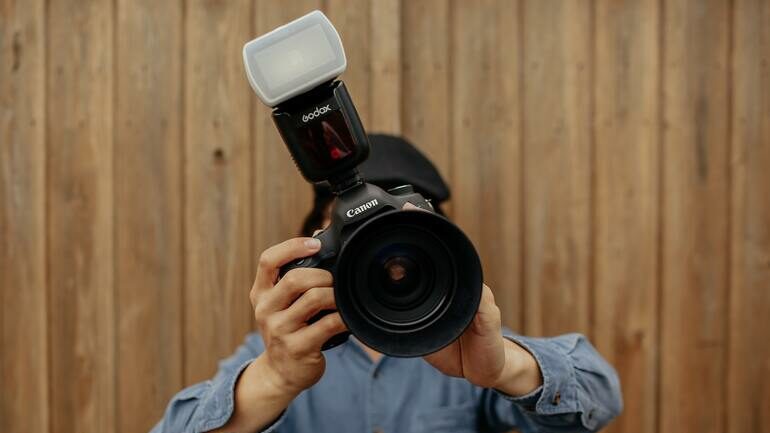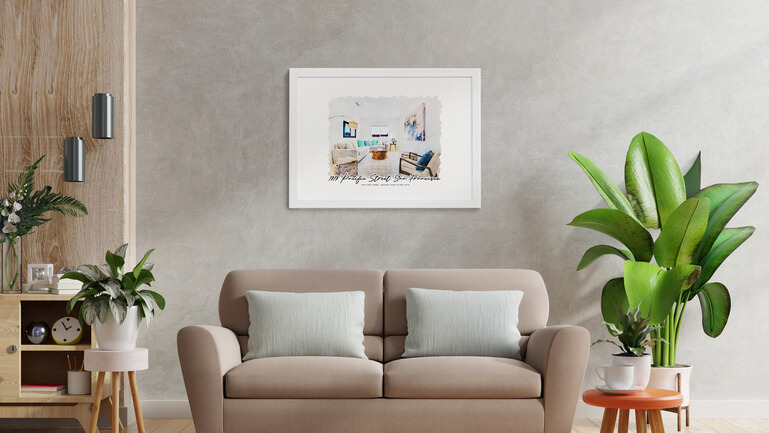Are you a real estate photographer looking to up your game and help your clients sell their homes faster? Check out our top 12 real estate photography tips!
Real estate photography is a vital part of the industry. 68% of potential buyers say that great photos made them want to visit the home. This means that your real estate photos are what get home searchers through the door.
From investing in the right equipment to nailing the perfect angle, taking quality photos can make or break a sale.
In this post, we’ll share 12 real estate photography tips to help your clients sell their homes faster. We’ll also discuss the best camera settings for real estate and other useful tips, so grab your camera and let’s get started!
What Settings Should I Use For Real Estate Photography?

First of all, you should always shoot in RAW instead of in JPEG. This will give you more control over the image’s exposure, highlights and shadows, white balance, contrast, and more. It also gives you more room to edit your images in post-production.
Second, the perfect depth of field lies between F8 and F11. In other words, the aperture should fall somewhere in between F8-F11 for optimum results.
Additionally, F5.6 and F16 are also acceptable but not recommended with outside edges of the range.
You can be flexible with the shutter speed on the other hand. Shutter speed is all about how long your lens is open for light to capture the shot.
Furthermore, higher shutter speeds require increasing the ISO value. Keep in mind that too high ISO can add a lot of digital noise to your photos. Try to set ISO below 400.
12 Real Estate Photography Tips to Help Sell A Home Faster
Here are 12 powerful real estate photography tips to help you shoot captivating photos that will help your clients sell their homes faster, and potentially even at a higher price.
1. Use a DSLR Camera for High-Quality Photos

DSLR cameras are a must-have for real estate photographers, as they offer high-quality photos that can’t be matched by any cellphone camera.
DSLRs allow you to capture stunning property photos with greater depth and detail, meaning your work will stand out from the crowd.
Plus, DSLRs give you the flexibility to customize settings like exposure and aperture to achieve the perfect shot in any given environment.
So if you’re serious about real estate photography and want to take your portfolio to the next level, investing in a good DSLR camera will pay off.
Check out our recommendation for DSLR cameras in our blog post on the best cameras for real estate photography.
2. Invest In a Tripod to Avoid Camera Shakes

As a real estate photographer, it’s well worth investing in a good tripod if you want to ensure crystal-clear images with zero camera shakes.
The tripod won’t only give you crisper shots at slower shutter speeds, but also provide a reliable base for all kinds of photography, from real estate shots to landscapes.
Using a tripod will make successful long exposures easier as well as allow you to fully experiment with light and movement.
And let’s not forget the huge convenience factor; without one you’ll be stuck in awkward positions trying to take that perfect photo, meaning tripod owners will savor the extra few precious minutes.
3. Capture the Whole Room With a Wide-Angle Lens

Investing in a wide-angle lens is one of the best investments that photographers can make. Taking wide shots captures the whole room, from corner to corner and ceiling to floor with ease.
Shooting wide also works great for portrait and landscape photography, as well as live events with larger groups.
Wide-angle lenses are an invaluable tool for capturing great interior shoots where you need to capture the whole room. You can find some great options in our blog post on the best lens for real estate photography.
4. Visit the Property in Advance

Before you begin capturing a property in all its glory, take the time to explore it. Look closely—each home has unique features that will make your photo session stand out from the competition.
While “walking around” familiarize yourself with every corner of both interior and exterior spaces and snap some photos for good measure if you feel that’s needed.
You may even uncover small details such as lighting or furniture placement (that would otherwise remain hidden). Check to make sure nothing needs tidying up or touch-ups before the photo session begins.
Doing so will guarantee perfect shots at any angle—all while helping bring potential homebuyers one step closer to their dream home.
5. Use Natural Light Whenever Possible

As photographers, natural light should be our best friend!
Taking advantage of natural light helps to capture natural colors, depth, and clarity that can’t be replicated in artificial scenarios.
Look for strategically placed natural light sources such as natural window lighting. Also, take advantage of the golden hour when the sun is setting to create a romantic and mystic glow to your photos.
Don’t worry if you can’t fit this short time window of sunset into your schedule. You can always edit twilight photos in post-processing.

Overall, natural light allows real estate photographers to take the most beautiful photos with a creative edge all while avoiding the stress that arises from managing additional flashlights or triggers.
Simply put – natural light is the key to achieving picture-perfect images!
High-Quality & Consistent
Real Estate Photo Editing
Hire a dedicated editor with performance metrics from $7/hour.
6. Be Creative With the Indoor Lighting

You should get creative with your real estate photography by playing around with indoor and outdoor lights.
Turning them off can give you a balanced temperature while having them on will add warmth and coziness to your photos.
However, regardless of which effect you’re going for don’t forget that light temperature correction is needed during post-processing.
Get more lighting tips in our blog post on 5 powerful real estate photography lighting tips for incredible results.
7. Take Multiple Shots of Each Room From Different Angles

Shooting multiple shots of each room you’re working on can be crucial to getting the right photos.
It gives you multiple angles, multiple contexts, and multiple lighting situations to work with so that you get the best shot every time.
Don’t just take one photo from one angle – make sure you rotate, crouch, step up, and shoot multiple angles.
This will help you find the most interesting perspectives and capture different lighting conditions for a variety of looks.
8. Consider Using External Flashes

Consider adding external flashes to your residential real estate photography equipment toolkit.
Why? As a rule, the standard flashes are too weak. Using them, you can’t take professional images with even lighting, so using an external flash will help you take better images.
For example, the Canon Speedlite 430EX III-RT offers powerful on-performance shots but is yet pocket-sized when packing up for shoots.
For more excellent options, visit our blog post on the best flashes for real estate photography.
9. Take Aerial Photography

Drones are the perfect way to snap stunning aerial images for real estate photography.
Not only do they help to capture the property from unique and interesting angles but they can also provide clients with a bird’s eye view of the neighborhood.
To ensure safety while flying drones over buildings or residential areas make sure that area isn’t restricted by downloading an app like B4UFLY which will detect airspace restrictions based on your location information.
10. Check Horizontal and Vertical Lines

Capturing the perfect shot means precision and attention to detail. When shooting interior or exterior scenes, it’s essential that you keep your lines in check to ensure they are straight.
If necessary, minor imperfections can be tweaked later with image editing programs like Photoshop for a flawless finish.
11. Use Virtual Staging if Shooting Vacant Properties
Vacant homes sell for an average of $11,306 less and spend 6 more days on market compared to staged and virtually staged homes.
Virtual staging can be a useful tool to help showcase vacant properties. Not only will it transform an empty space into a more inviting home, but it also brings out the full potential of the property.
Virtual staging is easy and cost-effective to use. It requires no physical furniture or decoration, so there’s no need for expensive set-ups or having to worry about transportation and setup logistics associated with using traditional staging.


Plus, virtual staging can be ordered online quickly; so you don’t have to worry about delays in completing the job.
Furthermore, using virtual staging allows buyers to visualize how their own furniture or decorations could look in the space, helping them make an informed decision about whether or not they would like to purchase the property.
Finally, adding virtual staging also gives your photographs an edge over listings without this additional layer of presentation, making your online portfolio stand out as well as making it easier for buyers to envision themselves living in the space.
High-Quality & Consistent
Real Estate Photo Editing
Hire a dedicated editor with performance metrics from $7/hour.
12. Don’t Forget to Edit Your Photos!
As a real estate photographer, you might be feeling overwhelmed by the sheer number of photos that need to be edited.
Going through all those images can be incredibly time-consuming, not to mention exhausting!
Thankfully, there’s an easier solution to achieve amazing real estate photo editing results. With a professional real estate photo editing service like PhotoUp, you can free up your time and energy so that you can focus on the artistry.


As an added bonus, you’ll benefit from the expertise of experienced real estate photo editors that understand how to make your images truly shine.
Starting at the low cost of $1.15 per image, PhotoUp has a team of highly talented real estate photo editors who are ready and eagerly waiting to take the editing off your plate.
For example, we can help with:
- Image brightness and exposure correction
- Color and tone adjustments
- Window masking and glare reduction
- Clutter and advanced object removal
- Line and angle corrections
- HDR editing and manual blending
- Harsh shadows, lack of light, etc.
- And much more.
Browse Top Dedicated
Real Estate Photo Editors
Ready-to-hire editors for real estate photo editing, and more.

On top of that, PhotoUp is a one-stop shop for all your real estate marketing needs and also offers additional services such as:
- Virtual staging
- Video editing
- Real estate photographer websites
- Single property websites
- Floor plans
- Property flyers
- House portraits
- Virtual Assistants
- And more.
Easy Ordering and Upload Process
Getting started using PhotoUp’s real estate photo editing service is super easy.
All you need to do is sign up for a free PhotoUp account, upload your images, add instructions, choose export settings and turnaround time, and that’s it!
PhotoUp Real Estate Photo Editing Uploader
Check out our real estate photo editing uploader tutorial to see how easy it is to get started:
It’s really that easy to get beautifully edited images returned to you in 24 hours or less!
So if you need a little extra help, look into signing up for a free PhotoUp account to ensure the highest quality real estate photos every time.
We hope this blog post gave you some valuable real estate photography tips to help you shoot stunning photos.
Before you go….
Preparing for a Real Estate Photoshoot PDF
Download our free Preparing for a Real Estate Photoshoot PDF as a reminder to bring to your photoshoot.
Now go and grab your camera and start shooting amazing real estate photography!
If you found this post useful, you may also want to check out the following resources:






